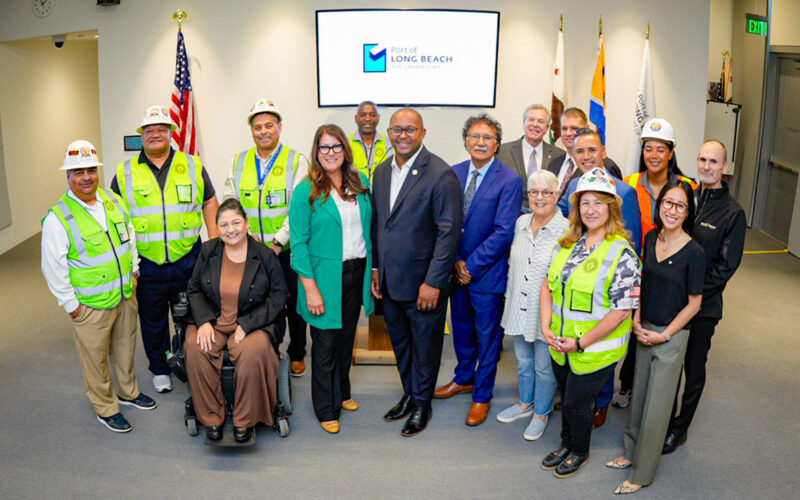The U.S. Department of Energy will grant up to $1.2 billion to a public-private partnership formed to lead San Pedro Bay ports to create a hydrogen hub.
The Ports of Long Beach and Los Angeles, which together comprise the nation’s largest seaport complex, are project partners in the effort to advance the use of hydrogen fuel in goods movement via ARCHES funding.
ARCHES funding will go to projects statewide. The two San Pedro Bay ports will find out in the coming months how much funding they will receive.
These funds, to be matched by the ports and their tenants, will involve deployment of hydrogen fuel cell cargo-handling equipment and mobile hydrogen fuelling trucks or stations in the ports’ terminals.
Subsequent phases will add additional cargo-handling equipment and support the statewide deployment of 5,000 hydrogen fuel cell heavy-duty trucks.
READ: Biden climate plan shifts away from trucks
“Investing federal dollars to establish a regional clean hydrogen hub is a home run for both our climate and economy,” said US Representative Robert Garcia.
“Thanks to the Bipartisan Infrastructure Law, we are providing crucial funding that will drive the nation towards reduced pollution and harmful greenhouse emissions.
“We will continue to fight for projects that will improve the quality of life for our communities, and I look forward to continuing to work with my colleagues to support our infrastructure and environmental goals,” Garcia added.
ARCHES is the Alliance for Renewable Clean Hydrogen Energy Systems. It administered California’s grant application for a green hydrogen hub under the U.S. Department of Energy’s Regional Clean Hydrogen Hubs (H2Hubs) programme. Funded by the Bipartisan Infrastructure Law, the H2Hubs programme will be one of the largest investments in the history of the Department of Energy.
READ: Port of Los Angeles records first gains in 13 months
“By establishing a Green Hydrogen Hub, we will now have the capacity to accelerate the production of renewable hydrogen that will clean our air, generate high-quality green jobs for our local communities, and help power California into the future,” said Long Beach Mayor Rex Richardson.
“I want to thank the Biden administration, the Department of Energy, and the broad coalition of labour, community, environmental groups, and business for delivering this historic investment toward a clean energy future for our community,” Richardson said.
The Port of Long Beach recently issued a request for information to gauge interest in developing hydrogen infrastructure in the harbour.
Numerous proposals were received, covering a variety of potential project types. The information will be used to determine the next steps for advancing hydrogen infrastructure in the port area.
READ: State grants Port of Long Beach $383 million for net-zero future
Together, the ports of Long Beach and Los Angeles created the landmark Clean Air Action Plan (CAAP).
This is a comprehensive strategy for accelerating progress toward a zero-emissions future while protecting and strengthening the ports’ competitive position in the global economy.
Targets for reducing greenhouse gases (GHG) from port-related sources were introduced in the CAAP’s 2017 update. The document calls for the ports to reduce GHG emissions 40 per cent below 1990 levels by 2030 and 80 per cent below 1990 levels by 2050.
The Clean Air Action Plan was originally approved in 2006.
This is the latest step undertaken by both Californian ports to reach its environmental targets.
Earlier this summer, port officials from Los Angeles and Nagoya signed a new Memorandum of Understanding (MoU) to expand collaboration on important environmental and operational efficiency measures.








